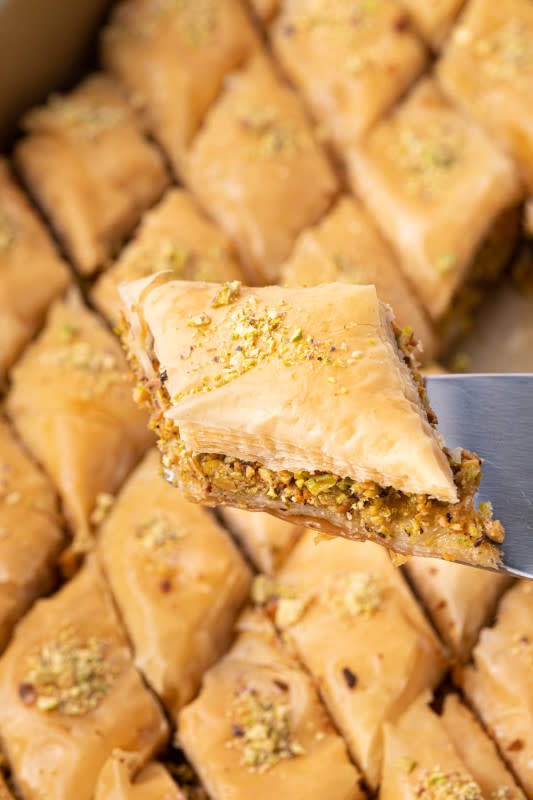This Nutty, Buttery Lebanese Baklava Recipe Has a Surprising Shortcut

Lebanese Baklava
I always remember my mom making baklava during Ramadan, especially at the end of Ramadan for Eid al-Fitr. It was the ultimate sign of celebration in my family. She would make double or triple the normal batch during the holidays and have it ready to serve our family and friends visiting us.
I still make baklava mostly during special occasions and for holidays. But what’s interesting is over the years, I discovered a quick foolproof method that literally takes 20 minutes to make instead of an hour. And now I turn to baklava a lot more often when I want a special dessert that looks like it took me more time to prepare than it did in reality. Here's what you need to know to make Lebanese baklava at home.
Related: 21 Amazing Arabic Sweets and Desserts
Where is Baklava From?
From my research, it seems that the exact origin can’t really be pinpointed to one country. Generally speaking, the dessert started in the Ottoman Empire by the Turks, was modified and popularized by the Greeks and then spread throughout the Mediterranean region, with each country adding its unique twists, including versions like the Lebanese baklava my family makes.
What Makes Lebanese Baklava Different?
What distinguishes Lebanese baklava from other versions is the popular simple syrup we use in many desserts like kanafa. The simple syrup is sugar cooked down with water to form a syrup to pour over the baklava. We add lemon juice and orange blossom water to give it that unique Lebanese flavor.

Yumna Jawad, Feel Good Foodie
What Ingredients Do You Need for Lebanese Baklava?
• Phyllo dough: The very thin pastry is the key ingredient for making baklava. You can find it in the freezer section.
• Nuts: Walnuts are a traditional choice, but pistachios are also commonly used to make baklava. To make the baklava filling you simply mix chopped nuts with sugar.
• Ghee: Melted butter is a key ingredient in baklava, but I prefer to use clarified butter or ghee (more on that below).
• Simple syrup: What makes this mixture simple is that all you have to do is heat sugar with water, stirring until the sugar dissolves. Simple syrup is often an equal ratio of water to sugar, but for baklava I prefer a little more sugar to water, which creates a slightly thicker syrup.
• Orange blossom water: This classic Middle Eastern ingredient, which is made by boiling orange blossoms, has a floral flavor, as you might imagine. You can find it at Middle Eastern markets or order it online.
Related: Wait, What's The Difference Between Phyllo Dough and Puff Pastry?
How to Make Lebanese Baklava
Traditional baklava is made by layering about 50-60 sheets of phyllo with clarified butter or ghee in the middle. I now divide all those sheets into two thick layers of phyllo with the nuts and sugar mixture in the middle. But the secret is to cut the layers and then pour the clarified butter or ghee on top and give it 10 minutes to soak into the layers of phyllo before baking.
To create baklava with a classic diamond pattern, make four cuts lengthwise in the pan, then make eight cuts crosswise on the diagonal, holding down the phyllo sheets with your other hand to keep everything steady. When you cut, point the knife down at an angle to make sure to cut through all the layers of the phyllo.
Once you have made your baklava, let it cool to room temperature. You can then lightly cover the tin with foil or parchment to store, or place the individual pieces into a container. You can store it in the fridge or at room temperature for up to 2 weeks.
The baklava also freezes really well, and it will keep for up to 3 months. Wrap the whole baking dish in plastic wrap and foil to freeze and thaw it at room temperature to serve.
Up next: 100 Ramadan Wishes and Greetings to Honor the Holy Month
Lebanese Baklava
Ingredients
1 cup granulated sugar
¾ cup water
1 tablespoon lemon juice
1 tablespoon orange blossom water
1. To make the simple syrup, combine the water, sugar and lemon juice in a small saucepan over medium-high heat. Bring mixture to a boil, then reduce heat to simmer, stirring occasionally until the sugar is dissolved and the mixture is thickened but still clear colored, about 5-7 minutes. Remove from heat, add the orange blossom water, and set aside to cool to room temperature.
2. To make the sugared nuts, in a large bowl, combine the walnuts and granulated sugar until well mixed.
3. Preheat the oven to 350°. Brush the bottom of a 9-by-13-inch pan with clarified butter.
4. Open the two sleeves of phyllo sheets—each will have about 20 sheets. Unroll them and cut off an inch at the end to make them fit into the 9-by-13-inch pan.
5. Lay one stack of 20 phyllo sheets in the pan. Add about 5-10 more phyllo sheets on top of the first stack. Spread the nut mixture over the phyllo in an even layer. Lay the remaining 10 to 15 phyllo sheets on top of the nuts.
6. Cut the baklava into diamonds by making 4 cuts lengthwise and 9 cuts crosswise on the diagonal, holding down the phyllo sheets with your other hand as you cut carefully.
7. Pour the melted clarified butter over the baklava evenly. Allow the butter to settle in, about 5 minutes.
8. Bake until golden brown all the way into the cut lines, about 50-60 minutes, rotating the baklava halfway through baking.
9. Remove the pan from the oven and immediately pour the cooled simple syrup evenly over the baklava. Allow to cool at room temperature for several hours before serving.
